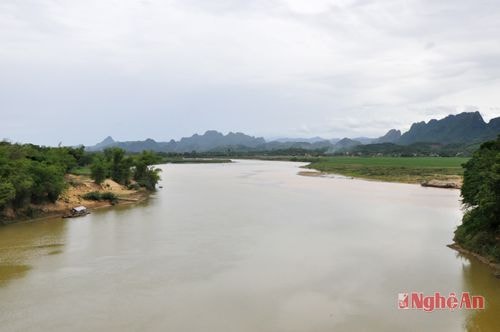Lemon Tree Junction
(Baonghean) - On the journey of hundreds of kilometers from upstream to Cua Hoi to join the immense ocean, it is impossible to count how many forks and confluences the Lam River passes through. Through each confluence, the river carries a cultural mark and adds a sacred value to that land. Cay Chanh fork (in Dinh Son commune - Anh Son) - where the Con River flows into the Lam River (local people call it the Cai River) also contains its own marks and values, contributing to the beauty of a rich midland countryside.
I have taken the trouble to find out the origin of the name Cay Chanh, which now covers almost the entire Dinh Son commune (Anh Son). But, up to now, I have not found a reasonable and convincing explanation, even though I have met many elders - those who were born, grew up and "anchored" on this land for almost their entire lives. I only know that the name was first used to identify the location of the river junction - the confluence of the Con and Cai rivers, and then people named this whole land.
From the confluence of the Nam Non and Nam Mo streams at Cua Rao (Tuong Duong), the Lam River receives additional water sources from the Cha Lap, Huoi Nguyen, Bo stream, Nam San, Thoi stream, Choang stream... And reaching Anh Son land, it meets the Con River to begin a new journey. The water no longer flows through rapids and rocky reefs, but has a leisurely appearance as if it is reluctant and wants to "make love". The Con River is joined by the Nam Giai, Nam Viec, Nam Quang, and Nam Ton streams in the districts of the Northwest region (Que Phong, Quy Chau, Quy Hop, Nghia Dan), then turns to Tan Ky, goes to Anh Son land to join the Cai River (mother river).
 |
| Cay Chanh Junction - the confluence of Lam River (Cai River) and Con River. |
Cay Chanh Junction is not only the confluence of two streams but also the confluence of two cultural regions of the Southwest and Northwest of Nghe An. And this is also the point of exchange and convergence of cultural beauties of the lowlands and the highlands. From Cay Chanh up to the Southwest and Northwest are the overlapping mountain ranges, the precarious villages and the Thai, Kho Mu, Tho and Mong folk songs imbued with the breath of the mountains and forests, of the village festivals. From here down are the alluvial plains and vast alluvial fields, green all year round with rice, corn, beans, peanuts, strawberries and sugarcane. The rich, green villages - the origin of the rustic and passionate, affectionate and lingering folk songs and chants. Names such as Mo beach, Hoi beach, Lang Trang beach, Dong Dua, Ben Hat evoke the fertility of the land and the poetic beauty of the landscape. And it was also in this place that people were born who devoted their lives to folk songs and vi melodies, and who made many contributions to the folk music treasure of Nghe An, such as musicians Thanh Luu, Van The and Meritorious Artist Tien Dung.
Geographically, Cay Chanh junction is the connecting point between districts on National Highway 7A and National Highway 48, between National Highways 7A and 7B, between the lowlands and the highlands. Because from here, you can go up to Con Cuong, Tuong Duong and Ky Son; turn to Tan Ky, Nghia Dan and Quy Hop; down to Do Luong, Yen Thanh and Dien Chau. Therefore, Cay Chanh area has many advantages to expand exchanges, promote trade, exchange of goods and accelerate the process of socio-economic development. In particular, when the bridge over Lam river was closed for several years, the bridge over Con river was also completed, giving Cay Chanh area in general, Cay Chanh junction in particular a new look. The sugar factory named Song Lam was also moved to build in the river junction area, helping farmers promote their production strengths, having more opportunities to "change their lives" thanks to raw sugarcane.
For a long time, Cay Chanh - Dinh Son has been known to friends near and far as a dynamic countryside in the process of socio-economic development, Cay Chanh market is a major trading point of the whole region. It is also understandable, once people know how to promote the advantages of space and geographical location of their locality. Cay Chanh market is increasingly bustling with the market and spacious high-rise buildings, and upgraded roads. All are contributing to the emergence of a modern urban area at the river junction, an urban area with rivers, mountains, and green fields that will certainly be more vibrant.
Cong Kien






